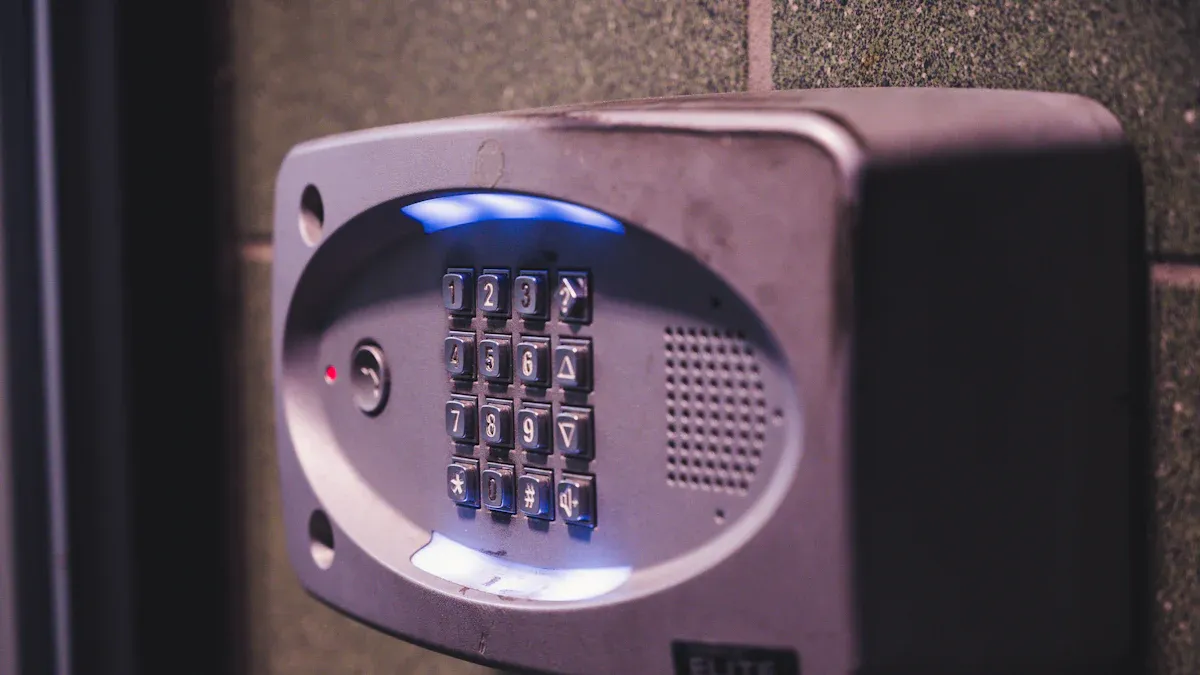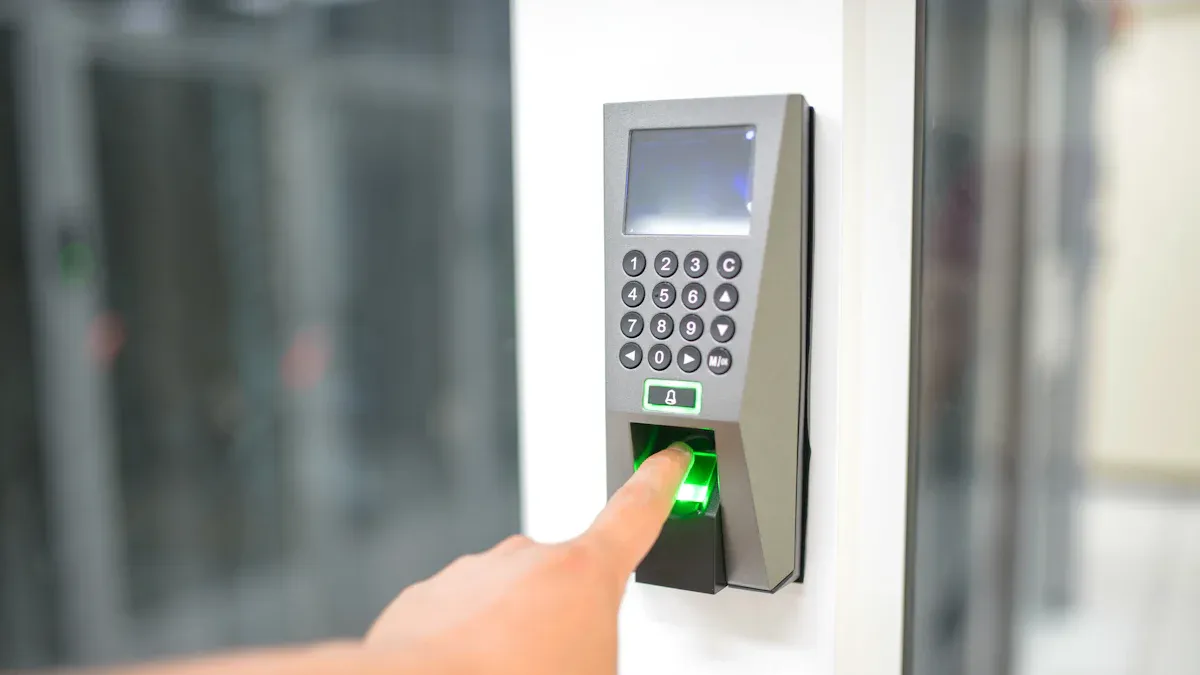
Modern facilities need strong security and efficient operations. Industrial access control keypads are crucial for achieving this. They provide robust, customizable solutions for managing entry. These systems easily surpass the limitations of older, traditional access methods.
キーテイクアウト
- Industrial access control keypads make facilities safer. They control who enters different areas. This stops unauthorized people from getting in.
- These keypads also make work run smoother. They help employees enter and exit quickly. This saves time and makes operations more efficient.
- Keypads are strong and work in tough places. They can connect to other security tools. This gives facilities better control and protection.
Enhancing Security with Industrial Access Control Keypads

Granular Access Control Capabilities
Industrial access control keypads give facilities precise control over who enters specific areas. You can set up different access levels for different employees. For example, only maintenance staff can enter the server room. Production workers might only access the factory floor. This means you decide exactly who goes where and when. This level of detail greatly improves security. It stops unauthorized people from getting into sensitive or dangerous zones.
Deterring Unauthorized Entry
The mere presence of an access control keypad acts as a strong deterrent. Potential intruders see a robust system. They know they cannot just walk in. Keypads require a specific code or credential. This makes forced entry much harder. It sends a clear message: this facility takes security seriously. This visible security measure often makes would-be trespassers think twice.
Comprehensive Audit Trails
Every time someone uses an industrial access control keypad, the system records it. It logs who entered, where they went, and at what time. This creates a detailed audit trail. Security personnel can review these logs. They can see all entry and exit activities. If an incident occurs, these records are invaluable. They help identify who was in a specific area at a particular time. This accountability boosts overall security.
Eliminating Physical Credential Risks
Traditional keys and access cards pose security risks. People can lose them. Someone might steal them. If this happens, your facility becomes vulnerable. Industrial access control keypads solve this problem. They rely on codes or biometric data. You can easily change codes if an employee leaves or if a code gets compromised. This removes the risk associated with physical credentials. It makes your security system much more flexible and secure.
Integration with Advanced Security Systems
Modern industrial access control keypads do not work alone. They integrate with other security technologies. You can connect them to CCTV cameras. When someone enters a code, the camera records it. They also link with alarm systems. If someone tries too many wrong codes, an alarm can sound. This creates a layered security approach. It gives facilities a comprehensive security network. This integration makes the entire security system stronger and more responsive.
Boosting Operational Efficiency with Industrial Access Control Keypads
Streamlined Entry and Exit Processes
Industrial access control keypads make coming and going much smoother. Employees do not wait for guards to open doors. They also do not fumble with physical keys. Instead, they quickly enter a code or swipe a card. This speeds up entry and exit. It reduces bottlenecks, especially when shifts change. Think about how quickly everyone can get to their workstations. This efficiency keeps operations moving without unnecessary delays.
Simplified Access Management
Managing who can enter different areas becomes very easy. You do not need to rekey locks if someone loses a key. You also do not collect physical keys when an employee leaves. Granting or taking away access is digital. It happens instantly. A central system controls everything. For example, a new employee gets access with just a few clicks. You can immediately remove a departing employee’s access. This saves a lot of time and effort.
Reducing Administrative Overhead
These systems cut down on paperwork. Staff spend less time managing physical keys or badges. The system keeps records automatically. This means less time dealing with lost key problems. Security staff can focus on more important tasks. They spend less time on manual access management. This reduction in administrative work frees up valuable resources.
Cost Savings and ROI
Industrial access control keypads save money over time. You no longer pay for replacing lost keys. You also avoid the cost of rekeying locks. Sometimes, facilities can even reduce the number of security personnel needed. Better efficiency leads to more productivity. This also saves money. It is a long-term investment that really pays off. Consider the money saved on locksmith fees and physical credential replacements.
Improving Workflow and Productivity
Smooth access helps work flow better. Employees spend less time waiting at doors. They move faster between different work zones. This lets them focus on their tasks. They do not worry about access issues. A secure environment also makes employees feel safer. This helps them concentrate and be more productive. An Industrial Access Control Keypad helps production lines run smoother. Workers move freely and efficiently. This directly boosts overall productivity.
Key Features and Considerations for Industrial Access Control Keypads

耐久性と環境抵抗
Industrial environments are tough. They often have dust, water, extreme temperatures, and even chemicals. A good access control keypad must handle these conditions. Manufacturers build these keypads with strong materials like stainless steel or heavy-duty plastics. They often carry IP ratings, like IP65 or IP67. These ratings show how well the keypad resists dust and water. You need a keypad that keeps working reliably, no matter what the factory floor throws at it.
Multiple Credential Options
Modern keypads offer more than just PIN codes. Many support different ways to grant access. You can find keypads that work with RFID cards or fobs. Some even use biometric scanning, like fingerprints. This gives facilities flexibility. They can choose the best method for their security needs and employee convenience. For example, a high-security area might use a PIN plus a fingerprint.
Networked vs. Standalone Systems
Facilities can choose between two main types of systems. Standalone keypads work independently. They store access codes directly on the device. These are good for single doors or smaller areas. Networked systems connect to a central computer. This allows for remote management and real-time monitoring. You can update access rights for many doors from one place. A networked Industrial Access Control Keypad offers more control and scalability for larger operations.
Ease of Installation and Maintenance
No one wants a complicated security system. Good industrial keypads are easy to install. They come with clear instructions. Maintenance should also be simple. This means quick troubleshooting and easy part replacement if needed. A user-friendly system saves time and reduces the need for specialized technicians. This keeps your security running smoothly without extra hassle.
Industrial Access Control Keypads are essential for modern facilities. They optimize both security and efficiency. Implementing these systems provides robust protection. They also streamline operations. Facilities gain greater control over their premises. This creates a safer and more productive environment.
よくある質問
What is the main benefit of industrial access control keypads?
They give facilities precise control over who enters specific areas. This boosts both security and operational efficiency.
Can these keypads handle tough industrial conditions?
Yes, manufacturers build them tough. They use strong materials and often have high IP ratings for dust and water resistance. 🛡️
How do these systems help with security?
They deter unauthorized entry, provide detailed audit trails, and eliminate risks from physical keys. They also integrate with other security systems.

